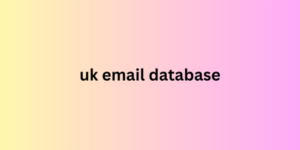Bubble FlutterFlow Cases Mobile development Our Students
My name is Sergey Bogdanets, I am 44 years old, and I am originally from Orel. I live here now, although I spent my school years in Saratov, where my parents moved. After school, I returned to Orel and entered the law department at Orel State University, which I graduated from in 2003. Despite my legal education, I never worked in my profession - I have been fascinated by technology, computers and programming since my youth.
My interest in programming
My first serious encounter with computers uk email database happened back in school. Those were the days when computers were rare and there were practically no programs. We got an old BK-010 computer, and in order to play, we had to write programs ourselves. I started with simple games, strategies - mostly text-based, without graphics. That's how I gradually got involved in programming.
After graduating from university, I did not work in my field. By that time, I already had a job at a company that developed websites. It was a time of rapid growth of the Internet, when companies began to realize en masse that they needed a website or an online store.

The first projects were simple: business card websites for local organizations, then came orders for online stores. We worked on the market for over ten years, and we had many large and small projects. We worked with companies from a variety of industries - from small stores to construction companies. I personally did programming in PHP, HTML and JavaScript, gradually mastering everything that was required to create functional web resources.
How I Got Into AI and No-Code
However, over time, I began to get tired of the same type of tasks. The projects were different, but the essence always came down to repeating the same actions. I was looking for ways to speed up processes to avoid constantly copying code and templates. This led me to neural networks. About three years ago, I began to study the possibilities of their application in programming, because I saw the potential for automating routine tasks.
If you want to automate your work or personal tasks with AI, come to our free online workshop "Neural Networks for Life and Career". There we will show you the most relevant and convenient methods that will help you get to know the work of artificial intelligence better and learn how to use it for yourself.
I heard about Zerocoder and decided to take a course on FlutterFlow because the ability to work with FlutterFlow will allow you to create applications of any complexity. No-code greatly reduces the time costs of designing applications.
During my studies I wrote two applications. One of them is a weather application that works on the API of weather sites.
My final project: the Expert app. I'll tell you more about it.
Expert application
In parallel with my main job, I was engaged in construction expertise. My partners and I worked on projects for construction companies, checked project documentation, assessed costs, and conducted construction expertise for customers.
This was another important stage in my career, where I realized that many processes can be automated. This is how the idea of creating an application for automating interactions between companies that need expertise and experts who conduct it arose.
I am developing this application on the FlutterFlow platform, and it is already functioning, although it is not yet fully completed. The essence of it is that the company uploads the design documentation, concludes a contract, and the documents are sent to experts for review. Everything is tracked through the system, which allows avoiding delays or data loss. I see the future in this, because such systems significantly facilitate work and reduce the human factor.
I didn't choose FlutterFlow by chance. Before that, I tried simpler platforms, such as Bubble, but they turned out to be limited. In Flutter, I can integrate code and not depend on the platform itself, which gives more opportunities for complex and large-scale projects. Of course, not everything always goes smoothly, sometimes bugs appear, but they are fixed, and the platform develops.